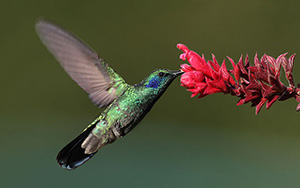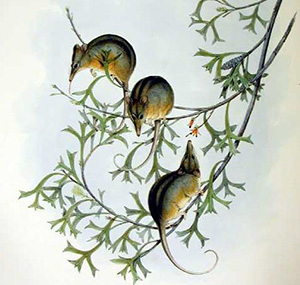Our Health Depends on Pollinators
By the Site Ecology Team (SET), Bill Willis (WAIT), Claire Long (OM)
July, 2015

Photo courtesy of Finca Lerida
When most people think of pollinators, it’s all about honeybees and maybe a few bumblebees thrown in for good measure. However, both bumblebees and honeybees can be very specific in what flowers they visit. If you’re a gardener, you’ve most likely noticed more than just these bees visiting the blossoms.
What do pollinators do? Why are they important?
To better identify pollinators, we must have an idea of what role they fill. Pollination is the act of transferring pollen grains from the male anther of one flower to the female stigma of another flower. When this transfer is successful, the flower is fertilized, which leads to seed development and fruit production. A successful pollination helps guarantee a plant’s continuing existence. Without pollinators, we’d have a hard time meeting the demand for crops around the world. Pollinators are considered a keystone species, meaning that a large number of other species depends upon them for their existence.

Photo courtesy of John Gould, F.R.S.
Pollinators are also considered an indicator species, with their well-being intimately connected with the overall health of the environment. Dramatic declines in pollinator populations have been attributed to three main factors: loss and fragmentation of habitat, degradation of remaining habitat, and pesticide poisoning. The honeybees, first introduced to the United States in the 1600s for honey and wax production, have recently seen dramatic population decline.
Other pollinators out there
It’s not only the honeybees and bumblebees that pollinate flowers in the United States. There are over 4000 native solitary bee species in the United States. Some solitary bee species are miner bees that live in the ground, while the remaining, approximately 70%, are cavity dwelling and nest in tunnels, cavities, and other crevices. Mason bees are common cavity dwellers and are heavy lifters when it comes to pollination. One thousand mason bees can do the pollination work of over 200,000 honeybees.
However, bees can’t take all the credit for pollination. Outside of bees, the most common pollinators are birds (such as the hummingbird), butterflies, beetles, bats, ants, moths, and flies. While pollinators may appear to be primarily small in size, there are plenty of other larger pollinators, including the lemur, and in Australia, the honey possum.
Furthermore, it’s not always animals and insects doing the heavy lifting. Grasses are pollinated by the wind; they produce fine grains of pollen that travels with the wind from plant to plant (so there is a reason to suffer through spring plant allergies; it’s helping plants survive). Corn, wheat, pine, and other hardwoods all depend on the wind for pollination.
For more information on the world of pollinators, and their role in food production, check out an article from Mother Earth Living.



